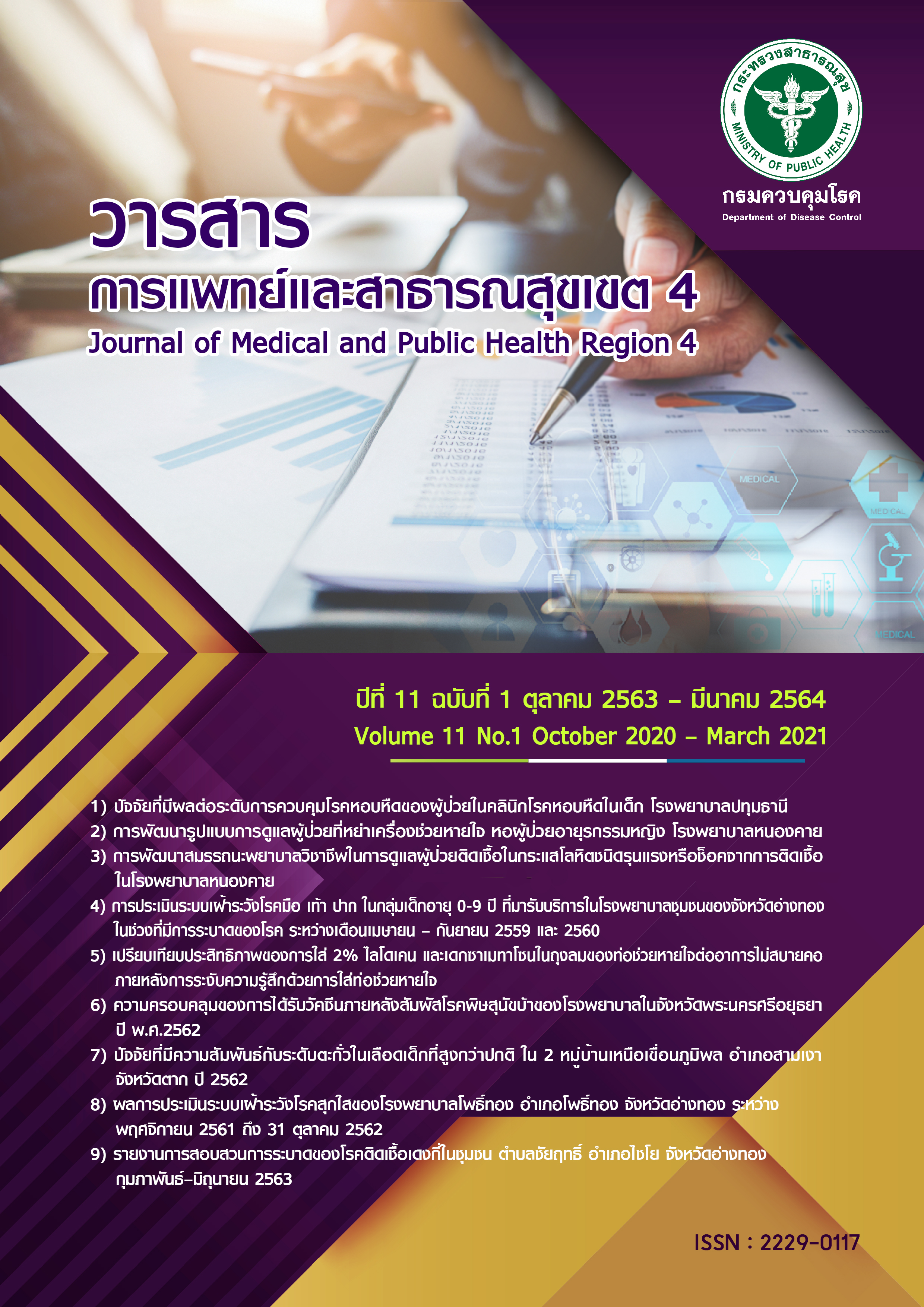Factor Associated with Childhood Asthma Control in Pediatric Asthma Clinic, Pathum Thani Hospital
Main Article Content
Abstract
The objectives of the study were to determine factors associated with childhood asthma control in pediatric asthma clinic, Pathum Thani Hospital. A total of 118 children in pediatric asthma clinic during January 2019 to December 2019 whom treated more than 3 months were included. Data were analyzed using mean, percentage, standard deviation, Mann-Whitney U test chi-square test and multiple logistic regression. 76 patients (64.4%) were well controlled and 42 patients (35.6%) were partially controlled and uncontrolled. Factor associated with uncontrolled asthma were family history of asthma (adjusted OR 7.72, 95%CI 2.55, 23.40) and secondhand smoke exposure at home (adjusted OR 7.15 95%CI 2.82, 18.11). This study confirmed the high prevalence of partially controlled and uncontrolled asthma in the asthma clinic. Thus it was recommended that health personnel should educate and promote all asthma patients to monitor self-care practice and control exposure to secondhand smoke at home in order to improve the care of asthma patients.
Article Details
References
2. พรชัย วัฒนรังสรรค์. ความรู้เรื่องโรคหืดของผู้ดูแล ระดับการควบคุมโรคและคุณภาพชีวิตของผู้ป่วยเด็กโรคหืด โรงพยาบาลเจ้าพระยายมราช. วารสารกุมารเวชศาสตร์ 2556; 52: 227-35.
3. พรศิลป์ บุญยะภักดิ์. ปาลีรัตน์ แก้วประดิษฐ์. ปัจจัยที่มีอิทธิพลต่อการควบคุมโรคหืดของผู้ป่วยโรคหืด โรงพยาบาลปากพนัง. วารสารวิชาการแพทย์เขต 11 2557; 28: 77-87.
4. สุจิตรา สีดาสี. ชนนิกานต์ วิไลฤทธิ์. ปัจจัยที่มีความสัมพันธ์กับระดับการควบคุมโรคหืดในผู้ป่วยที่ได้รับการรักษาในโรงพยาบาลลำปลายมาศ จังหวัดบุรีรัมย์. วารสารวิชาการสาธารณสุข 2557; 23: 30-36.
5. ชลธิชา ตั้งชีววัฒนากุล. ปัจจัยที่มีผลต่อการควบคุมอาการของผู้ป่วยโรคหอบหืด โรงพยาบาลพังงา. วารสารวิชาการแพทย์เขต 11 2561; 32: 1269-82.
6. กนกพร ศรีรัตนวงค์, ปิยรัตน์ ปรีดียานนท์, อรพรรณโพชนกูล, ความรู้เรื่องโรคหืดของผู้ดูแล ระดับการควบคุมโรคและคุณภาพชีวิตของผู้ป่วยเด็กโรคหืดในโรงพยาบาลธรรมศาสตร์. วารสารกุมารเวชศาสตร์ 2553; 49: 255-62.
7. Ghandi PK, Kenzik KM, Thompson LA, DeWalt DA, Revicki DA, Shenkman EA, et al. Exploring factors influencing asthma control and asthma specific health related quality of life among children. Respir Res 2013; 14(1): 26.
8. McGhan SL, MacDonald C, James DE, Naidu P, Wong E, Sharpe H, et al. Factor associated with poor asthma control in children aged five to 13 years. Can Respir J 2006; 13(1): 23-9.
9. AI-Zahrani JM, Ahmad A, AL-Harbi A, Khan AM, AI-Bader B, Baharoon S, et al.Factors associated with poor asthma control in the outpatient clinic setting. Ann Thorac Med 2015; 10(2):100-4.
10. AI-Jahdali H, Ahmed A, AI-Harbi A, Khan M, Baharoon S, Bin Salih S, et al. Improper inhaler technique is associated with poor asthma control and frequent emergency department. Allergy Asthma ClinImmunol 2013; 9(1): 8.
11. AI-Muhsen S, Horanieh N, Dulgom S, Aseri ZA, Vazquez-Tello A, Halwani R, et al.Poor asthma education and medication compliance are associated with increased emergency department visits by asthmatic children. Ann Thorac Med 2015; 10(2): 123-31.
12. แนวทางการวินิจฉัย และการรักษาโรคหอบหืดในประเทศไทยสำหรับผู้ป่วยเด็ก พ.ศ. 2558-2559 (The Thai National Guideline for diagnosis and Management of Childhood of Asthma) [Internet]. ราชวิทยาลัยกุมารแพทย์แห่งประเทศไทย. [สืบค้นเมื่อ 23 พฤษภาคม 2563]. เข้าถึงได้จาก
http://www.thaipediatrics.org/attachfile/Asthmaguideline.pdf.
13. De Onis M, Onyango AW, Borghi E, Siyam A, Nishida C, Siekmann J. Development of a WHO growth reference for school-aged children and adolescents, Bull World Health Organ 2007; 85(9):660-7.
14. Smith LA, Bokhour B, Hohman KH, Miroshnik I, Kleinman KP, Cohn E, et al. Modifiable risk factors for suboptimal control and controller medication underuse among children with asthma. Pediatrics 2008, 122(4): 760–69.
15. Lozano P, Finkelstein JA, Hecht J, Shulruff R, Weiss KB. Asthma medication use and disease burden in children in a primary care population. Arch Pediatr Adolesc Med 2003; 157(1): 81–88.
16. Koster ES, Raaijmakers JA, Vijverberg SJ, Koenderman L, Postma DS, Koppelman GH, et al. Limited agreement between current and long-term asthma control in children: The PACMAN cohort study. PediatrAllergyImmunol 2011; 22(8): 776–83.
17. Stanford RH, Gilsenan AW, Ziemiecki R, Zhou X, Lincourt WR. Predictors of uncontrolled asthma in adult and pediatric patients: Analysis of the asthma control characteristics and prevalence survey studies (ACCESS). J Asthma 2010; 47(3): 257-62.
18. Quinto KB, Zuraw BL, Poon K, Chen W, Schatz M, Christiansen SC. The association of obesity and asthma severity and control in children. J Allergy Clin Immunol 2011; 128(5): 964-69.
19. Bates JH. Physiological Mechanisms of Airway Hyperresponsiveness in Obese Asthma. Am J Respir Cell Mol Biol 2016; 54(5): 618-23.
20. Burke H, Bee JL, Hashim A, Abata HP, Chen Y, Cook DG, et al. Prenatal and passive smoke exposure and incidence of asthma and wheeze: Systematic review and meta analysis. Pediatrics 2012; 129(4): 735-44.
21. Wang Z, May SM, Charoenlap S, Pyle R, Ott NL, Mohammed K, et al. Effects of secondhand smoke exposure on asthma morbidity and health care utilization in children: a systematic review and meta-analysis. Ann Allergy Asthma Immunol 2015; 115: 396-401.


